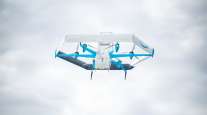Landmark Rule Opens Skies to More Commercial Drones

The Obama administration is opening U.S. skies to more commercial drones with long-awaited regulations that the government hopes will spawn new industries for inspecting bridges, monitoring crops and taking aerial photography.
In the most comprehensive set of rules yet for the burgeoning unmanned aircraft industry, the U.S. Federal Aviation Administration on June 21 went far beyond its original restrictive proposal issued last year. Drone operators will be able to petition the agency to fly beyond the horizon, at night and over people if they can show such flights are safe.
"We are in the early days of an aviation revolution that will change the way we do business, keep people safe, and gather information about our world,” President Barack Obama said in an interview with Bloomberg News. “This is just a first step, but this is the kind of innovative thinking that helps make change work for us — not only to grow the economy, but to improve the lives of the American people."
The new regulations, which will become effective two months from publication in the Federal Register, took years to craft and are seen as a critical step toward realizing the potential of drones to perform such tasks as monitoring crops, inspecting power lines and pipelines as well as assisting government agencies in disasters.
The basic rules permit only low-level flights that remain within sight of an operator or nearby assistant and don’t go over people. Drone operators-for-hire will have to pass a written test and be vetted by the Transportation Security Administration — but no longer need to be airplane pilots as current law requires. Drones under the regulation must weight less than 55 pounds and keep speeds below 100 miles per hour.
Allowing a device to be within eyesight of an assistant — a change from the proposed rules industry advocates won in the final version — means an operator can guide a drone by its video signal.
Drone package deliveries by companies such as Amazon.com Inc. and Alphabet Inc.’s Google Project Wing aren’t allowed under the regulations until FAA writes separate rules governing their use. Similarly, the limitations in the regulations won’t permit longer flights for agricultural flyovers, pipeline and utility inspections and news media photography over crowds.
However, the agency heeded industry comments to its earlier proposal and added flexibility so that many such activities would be permitted under a waiver program, FAA Administrator Michael Huerta said in a telephone briefing.
“Our focus is to make this as streamlined as possible,” Huerta said. The agency will open an online portal through which applicants can learn how to file for waivers, he said.
Solving the more complex problems inherent in drone deliveries — which envision autonomous vehicles buzzing over highly populated areas — is a “very active research program,” Huerta said. He declined to set a timetable on when such flights would be permitted.
While the rules don’t apply directly to hobbyists, who don’t need a license to fly if they’ve registered their drones with FAA, it lays out the government’s authority to enforce aviation regulations on all unmanned aircraft.
Drone advocacy groups called the regulations a symbolic victory that paves the way for those future uses. The Association for Unmanned Vehicle Systems International trade group forecasts drones will produce $82 billion in economic value and create more than 100,000 new jobs in the first 10 years after widespread flights are approved.
“I regard it as a significant milestone,” said AUVSI President Brian Wynne, who had been pushing FAA to issue the regulations for years. “We’ll accelerate the process of understanding what the risks are that will allow us to move on to more complex operations.”
The release of the rules puts the U.S. ahead of Europe in setting standards for the drone industry. The European Union has yet to adopt comprehensive rules for civilian drones, according to the European Aviation Safety Agency website. Individual nations have imposed restrictions, but they differ across borders. EASA is trying to develop rules by 2017.
FAA has already convened groups to study how to eventually allow such flights without waivers. Test programs are examining how to: approve long-range drone flights in which an operator steers with video images; make unmanned crafts safe to fly over people; and expand agricultural uses.
FAA has permitted commercial drone operations — those conducted for hire, as opposed to recreational flights by hobbyists who don’t need a license — since September 2014 under a case-by-case exemption process ordered by Congress. Drone operators under this program had to have a traditional pilot’s license. As of June 2, the agency had granted 6,004 such permits to fly drones commercially.
The new regulation allows a far easier approval process and is expected to swell the ranks of commercial operators. The agency is dropping the requirement for a pilots’ license, relying instead on a simpler knowledge test. FAA-approved drone operators will have more leeway to fly different drone models and multiple missions.




